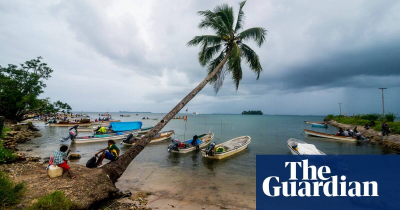The Guardian - China-Australias support to Pacific surges as China focuses on friendly states aid map shows
October 30, 2023 4 min 731 words
这则报道反映了澳大利亚在太平洋地区的援助显著增加,与此同时,中国将其发展融资重点放在“友好”的太平洋岛国。根据Lowy Institute Pacific Aid Map的数据,澳大利亚成为该地区主要的贷款来源,同时为基础设施支持带来了大幅度增长。这是一个重要发展,特别是在太平洋地区面临债务可持续性风险上升的时刻。 澳大利亚在过去几年不断提高其对太平洋的援助,尤其是基础设施领域。这显示了澳大利亚在该地区的地缘政治和经济重要性。然而,中国的发展融资策略更为精确,将重点放在对中国友好的国家上,这可能会加大债务风险。 对于太平洋岛国来说,这两个国家的援助都非常重要,因为它们需要大量的外部支持来建设新的基础设施,同时还需要应对气候变化等挑战。这篇报道强调了援助资金的重要性,也反映了澳大利亚和中国在该地区的竞争。需要密切关注这一地区的发展,以确保援助资金的合理分配和地区的可持续发展。
Australia dramatically increased its overall support to the Pacific in 2021, while Beijing is targeting its development financing to “the most China-friendly Pacific island states”, the latest Lowy Institute Pacific Aid Map shows.
The map, released on Tuesday, also revealed that at a time of elevated debt sustainability risks in the Pacific, Australia has become the leading source of loans and contributed to a surge in infrastructure support.
“Australia looks set to become the region’s dominant infrastructure financier, having committed an additional $780m in new projects,” the Lowy Institute research associate and map co-producer, Riley Duke, said.
The map draws on more that 70m data points, from publicly available documents and other sources, to track the flow of aid and development funds to the region. The 14 Pacific Island nations tracked received a record $4.8bn in official development finance (ODF) in 2021.
Alexandre Dayant, a Lowy Institute research fellow and project director of the Pacific Aid Map, said the map revealed a “new era” of development financing with supporting nations introducing new financing instruments. In the past, Pacific development financing relied heavily on grants from donors for governance and human development. This has shifted, with donors increasing their use of direct budget support and loans to deliver ODF, the Lowy Institute said. This type of funding shift can increase debt sustainability risks for the region, the institute added.
Australia is the Pacific’s largest development partner, disbursing $17bn between 2008 and 2021, making up nearly 40% of the region’s ODF. The Lowy Institute said Australia’s high level of ODF support to the Pacific was “followed at a distance” by the Asian Development Bank, China, New Zealand and Japan.
In 2021, Australia committed $1.89bn in ODF – up from $968m in 2020 and $1.34bn in 2019. Australia extended a $466m loan to Papua New Guinea in 2021, making it the largest transaction ever recorded in the Pacific Aid Map.
The 77% increase in Australia’s infrastructure commitments in the Pacific comes as Pacific Island governments need “significant external support” to build new and maintain existing roads, ports and telecommunications infrastructure, Duke said.
In 2021, Papua New Guinea was the top aid recipient, receiving nearly half of all financing (44%), followed by Fiji (15%), Solomon Islands (7%) and Vanuatu (5%). The most aid received per capita went to Tuvalu and Niue with Papua New Guinea ranking last per capita, even though the overall amount was highest.
The map showed China’s total development finance disbursements fell to $241m in 2021, below its pre-pandemic historical average of $285m a year. The Lowy Institute said Beijing’s financing had become “more strategically targeted at the most China-friendly Pacific Island states”.
The institute also noted that China’s decreasing ODF engagement “has not signalled a wholesale departure from the region, but rather a strategic shift to reduce risk, cement political ties, and enhance capital returns”.
With Pacific Island states facing enormous infrastructure financing gaps, China’s once dominant role has dwindled as Australia and like-minded partners provide more support in the region. Between 2008 and 2021, China was the third largest Pacific donor, but only the seventh largest for 2021 alone.
Reaching its high-water mark in 2016, China’s share of Pacific development financing has declined significantly. At its peak, China accounted for 14% of annual support to the region, but in 2021 it contributed less than 5%.
China’s infrastructure spending has almost halved over the past five years. Meanwhile, China is funding much of the 2023 Pacific Games, which will be hosted by Solomon Islands in November.
Citing Samoa’s 2021 cancellation of a $100m infrastructure loan from China as an example, Dayant said the decline in demand for Chinese loans amid an economic slowdown makes domestic spending more appealing for Beijing.
In a vast region with small, dispersed populations, for Pacific Island states reliant on tourism and labour mobility, development financing plays an outsized role as they recover from pandemic impacts and face existential threats from the climate crisis.
This year, for the first time, the map includes figures on climate development financing and a new feature tracking gender equality funding. Dayant said that funding to meet the goals of climate adaptation and mitigation, and gender equality projects is slowly increasing but still far from what is needed.
He notes that Australia now requires gender equality objectives in all ODF projects over $3m, potentially increasing Pacific regional gender initiative financing by one-third.

